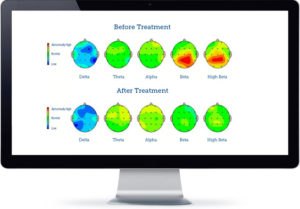Anxiety and the impact neurofeedback therapy can have on reducing symptoms
Anxiety is a normal emotion in humans. Many years ago, the emotion of anxiety was relied on by our ancestors to stay safe. Being in a heightened state of awareness with increased heart rate and blood pressure and hyper-alert senses, hunters could spot—and respond quickly—to a real threat such as a lurking predator. The surge of adrenaline that is present during anxiety helps humans to run away faster, or fight harder. We now refer to this emotional state as “fight or flight”.
Where fear is an immediate response to a real situation, anxiety is a less intense emotion where the brain is reacting to perceived fear or danger. For example, you may have anxiety about the possibility of sharks being in the water when you go swimming in the ocean, but you’d experience fear if you actually saw a shark.
Most people experience some form of anxiety in their life. Many times, it’s triggered by an event or stressful situation, for example taking an important test, interviewing for a new job, or giving a presentation to a large group of people, The temptation might be to run from the situation (flight), but most people face their fears (fight) and overcome the situation. Once the event is over, the anxiety goes away.
An anxiety disorder results when the flight or fight response becomes triggered too easily and too frequently, or is a constant presence, seemingly not related to a specific event, hijacking the brain and making it difficult to think or act rationally. Anxiety in this state can have a negative impact on the ability to live a normal life.

Recognizing the symptoms of an anxiety disorder
Anxiety disorders are the most common form of emotional disorder and can affect anyone at any age. If you experience any of the following 5 symptoms, it could be a sign that you have an anxiety disorder.
- Excessive worrying. If you find yourself, or your child, worrying to an extreme about a problem or an event, caught in the looping thoughts that are disproportionate to the real or imagined worry or issue, you might have an anxiety disorder. For example, anxiety and nerves would be a normal reaction to talking in front of a large group of people, but not so much that it interferes with your ability to do it. If this anxiety then becomes a fear of speaking in any situation, and occurs on most days, being difficult to control, it has become an anxiety disorder.
- A constant feeling of restlessness. Someone suffering from an anxiety disorder often has a feeling of something being “off” but without being able to pinpoint what exactly it is.
- Physical symptoms . Anxiety disorders can be accompanied by a racing pulse, sweaty palms, shaky hands, dizziness or dry mouth.
- Trouble sleeping. If your emotions and worries are keeping you up at night, or cause you to wake in the night without being able to go back to sleep, it can indicate you have an anxiety disorder.
- Social avoidance. When your anxious feelings or irrational fears stop you attending events or social situations, it can indicate a larger problem.
Anxiety disorders, like panic disorder or social anxiety disorder, may require therapy to allow patients to lead normal, happy lives.

What causes anxiety?
The exact cause of anxiety is unknown. Until recently, scientists believed that a small area of the brain called the amygdala served as the hub of fear and anxiety. Inappropriate fear and anxiety were, it was believed, caused by a hyperactive amygdala. Today, however, it’s believed that anxiety is actually the result of connections between different brain regions, and that no one brain region drives anxiety on its own. Gaining direct control over these connections can allow patients to regulate their anxiety without medication.
One theory is that the brain is split into two parts: a cognitive brain and an emotional brain. The amygdala is part of the emotional brain. Anxiety is experienced when the signals from the emotional brain overpower the cognitive brain, and into our consciousness. The anxious feelings of there being sharks in the water when you go for a swim is a rational fear, because there have been shark attacks in the past. However, your cognitive brain tells you that the chances of an attack happening are very rare, and you continue to swim. When the emotional brain overrides the cognitive brain, however, the fear becomes so great that it stops you from setting foot in the water.
Thankfully, there is help for patients suffering from anxiety in the way of medications, and different forms of therapy. Unfortunately, while anxiety medication may temporarily help with anxiety relief, it usually doesn’t address the root cause, and can negatively reinforce avoidance behaviors instead of encouraging the patient to learn how to deal with stress and uncomfortable feelings. One type of behavioral therapy involves gradually exposing patients to the triggers that set off their anxiety, and over time, patients learn to realize that these situations don’t lead to actual harm.
Other techniques such as neurofeedback therapy are used for self-regulation of anxiety symptoms, creating permanent changes to the brain waves that are believed to cause anxiety, bringing the brain back towards a healthier state.

How Neurofeedback helps lower anxiety
Almost any brain can be trained to function better through self-regulation. For sufferers of anxiety, this self-regulation calms the central nervous system, reducing or eliminating anxious symptoms.
Before any neurofeedback training is started, a QEEG (Quantitative electroencephalography) brain map is generated to get a benchmark of how the brain is currently functioning. This information is collected from sensors placed at specific sites on the brain. The QEEG brain map shows the doctors which areas of a client’s brain is exhibiting too much or too little activity, or areas where the brain is not communicating with other areas of the brain as best it could, resulting in undesired behaviors or feelings. For example, the brain of an individual dealing with anxiety often exhibits over-activity in the part that deals with us having conscious thoughts called the cortex.
These areas of under or over activity become the target of the biofeedback training. Using FDA approved equipment that the patient takes home with them, and after receiving comprehensive training on how to use the equipment, the client can complete 4-5 neurotherapy training sessions in their own home, teaching their brain to operate more efficiently. By changing brain wave patterns and improving the ability to self-regulate brain waves on a more consistent basis, anxiety responses decrease and the patient will start to experience a calmer brain of which they are in more control.
Anxiety is a normal reaction at time in most humans—it’s part of what makes us human. But too much anxiety leads to an anxiety disorder that can be debilitating, and significantly impact the quality of life of not only the sufferer, but also those closest to them. Anxiety medications can help, but the results are not permanent, and when the medication stops the anxiety can return. Neurotherapy has proven to be an effective natural, drug-free alternative that allows patients to self-regulate their brain waves, significantly reducing, and even eliminating anxiety symptoms.
Take the first step toward permanent relief from anxiety, and contact St. Louis Neurotherapy Institute to receive a free consultation and see if neurotherapy feedback is the right treatment option for you or your child.




